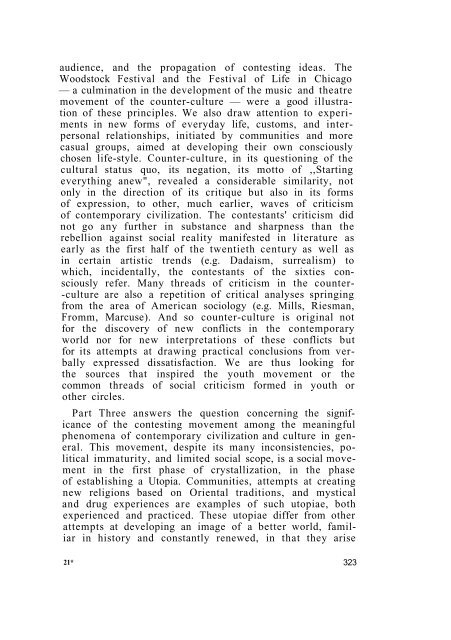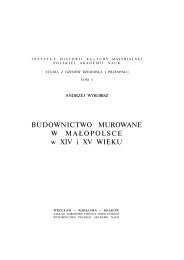- Page 1 and 2:
Aldona Jawłowska drogi kontrkultur
- Page 3 and 4:
-polityczne oraz postawy łączą s
- Page 5 and 6:
wane działania długofalowe — i
- Page 7 and 8:
z „wojną" hipisów na placu Picc
- Page 9 and 10:
ze i dramaturgii i dzięki tej tran
- Page 11 and 12:
ukazały się w Polsce, dostarczaj
- Page 13 and 14:
ja kontestacyjnych wartości i post
- Page 15 and 16:
żujących władzę i manipulujący
- Page 17 and 18:
oparcie. Wymienić tu trzeba przede
- Page 19 and 20:
kującymi świadomie ideologicznych
- Page 21 and 22:
potkina — Jeunesse Communiste Rev
- Page 23 and 24:
wspólnym, choć różnie interpret
- Page 25 and 26:
i socjologię i wprowadzić jako ob
- Page 27 and 28:
kich ułatwiał Komitet Koordynacyj
- Page 29 and 30:
wymaganiom człowieka (Technology a
- Page 31 and 32:
formy neokolonializmu oraz położe
- Page 33 and 34:
To co było przedmiotem krytyki pro
- Page 35 and 36:
(National Union of Students — NUS
- Page 37 and 38:
staje się marsz antyrasistowski i
- Page 39 and 40:
i zdezorientowanych, zaangażowanie
- Page 41 and 42:
Jesteśmy przekonani, że powinni b
- Page 43 and 44:
walczącymi o wolność samostanowi
- Page 45 and 46:
asowej. Przeciw polityce wojny, ci
- Page 47 and 48:
Francisco w State College. W czerwc
- Page 49 and 50:
aby wszystkie kraje członkowskie o
- Page 51 and 52:
piano policjantów i pytano, co my
- Page 53 and 54:
potrzebę dyskusji nad sytuacją po
- Page 55 and 56:
szczyźnie generalnego konfliktu: s
- Page 57 and 58:
kiego rozwoju wypadków. W lecie ad
- Page 59 and 60:
następnym manifestacje i wiece sol
- Page 61 and 62:
sklepy, specjalne grupy do walki z
- Page 63 and 64:
5. Pełne wyzwolenie kobiet jest ni
- Page 65 and 66:
my referendum, które zadecydowało
- Page 67 and 68:
mnianych już sprawach: cofnięcie
- Page 69 and 70:
wersytetu i walką o ich realizacj
- Page 71 and 72:
jej aspektach ekonomicznych, polity
- Page 73 and 74:
tury ruchu, określając się w dzi
- Page 75 and 76:
W dniach tych trwają nieprzerwane
- Page 77 and 78:
działania podjętego przez solidar
- Page 79 and 80:
łatwość ekspresji (tak rozumiane
- Page 81 and 82:
ez pośrednictwa zbiurokratyzowanyc
- Page 83 and 84:
opracowany przez Fiorentino Sullo,
- Page 85 and 86:
jego pobytu w Berlinie Zachodnim. W
- Page 87 and 88:
który należy stworzyć. Otwieramy
- Page 89 and 90:
wowych sprawach główne nurty ruch
- Page 91 and 92:
nie kontestacyjnych poglądów i wa
- Page 93 and 94:
kontynuowaniem przez administrację
- Page 95 and 96:
więc ruch jako całość przeszed
- Page 97 and 98:
zdecydowanie nie Studenci RFN Młod
- Page 99 and 100:
młodych ludzi w życiu codziennym.
- Page 101 and 102:
przeszkodę, utrudniającą budowę
- Page 103 and 104:
wych metod i pojęć, zdolnych prze
- Page 105 and 106:
domość wolności. „W systemie d
- Page 107 and 108:
chowań dewiacyjnych, gdyż w dosko
- Page 109 and 110:
„Uważano, że równolegle toczą
- Page 111 and 112:
2. DESTRUKCJA W IMIĘ TWORZENIA NOW
- Page 113 and 114:
podstawowym celem sytuacjonistów.
- Page 115 and 116:
form organizacji społecznej będą
- Page 117 and 118:
dych intelektualistów, był bardzo
- Page 119 and 120:
mywanym przez CAL, UNEF, SNE-Sup. i
- Page 121 and 122:
kich kontaktów, opartych na sponta
- Page 123 and 124:
autorytetem, ukazując możliwości
- Page 125 and 126:
Czarne Maski w Nowym Jorku, nawiąz
- Page 127 and 128:
całkowicie nowej. Po raz pierwszy
- Page 129 and 130:
łecznych. Partia prowadziła włas
- Page 131 and 132:
W dniu «otwarcia» Państwa Pomara
- Page 133 and 134:
może mieć to, czego potrzebuje, r
- Page 135 and 136:
zginęło w jednej manifestacji w r
- Page 137 and 138:
W strefie wolnej jesteśmy krótko
- Page 139 and 140:
nieniami. Przejawy wrogości doprow
- Page 141 and 142:
dy. Domy osłaniają was przed życ
- Page 143 and 144:
W odpowiedzi na próby propagandy p
- Page 145 and 146:
proces. Musimy doprowadzić do sytu
- Page 147 and 148:
wyższe miejsce w nowej hierarchii
- Page 149 and 150:
chodzi tu interesująca zbieżnoś
- Page 151 and 152:
przekształcił się w ruch Yippies
- Page 153 and 154:
się na władzy niewielu ludzi, lec
- Page 155 and 156:
zareagowała na zabawy yipisów wyj
- Page 157 and 158:
skowej. Tysiące mężczyzn zmuszon
- Page 159 and 160:
z innymi organizacjami kontestacyjn
- Page 161 and 162:
łatwiej było zabijać i łatwiej
- Page 163 and 164:
WITCH żyje i śmieje się w każde
- Page 165 and 166:
SYSTEM KSZTAŁCENIA Kontestacyjna k
- Page 167 and 168:
Jeśli prawda konstytuuje się popr
- Page 169 and 170:
w burżuazyjnym uniwersytecie. Tam
- Page 171 and 172:
wpływu. W ten sposób szkolnictwo
- Page 173 and 174:
więcej o społeczeństwie ameryka
- Page 175 and 176:
gdy się ktoś znalazł, był niety
- Page 177 and 178:
cych aktywnie uczestniczyć w demok
- Page 179 and 180:
* W amerykańskim ruchu młodzieży
- Page 181 and 182:
dokonywać ponownego określenia w
- Page 183 and 184:
du wzrastającego zaangażowania w
- Page 185 and 186:
zując bezpośrednie powiązania z
- Page 187 and 188:
znacznej części należnych im inf
- Page 189 and 190:
ie. Choroba psychiczna jest ideolog
- Page 191 and 192:
kumentarne, collage, pieśni, poezj
- Page 193 and 194:
całej młodzieży, własne gazety
- Page 195 and 196:
nej. Agencja w Massachusetts — na
- Page 197 and 198:
decyzji, cele ze środkami. Świat
- Page 199 and 200:
odźcami środowiska. Burżuazyjne
- Page 201 and 202:
kształcaniu przedmiotów codzienne
- Page 203 and 204:
4. KONTRKULTURA Zakwestionowanie ku
- Page 205 and 206:
cych się w tym rodzaju muzyki jest
- Page 207 and 208:
mają odpowiednie instrumenty i śr
- Page 209 and 210:
Wszędzie słyszę dźwięk maszeru
- Page 211 and 212:
miany poglądów, sytuację „byci
- Page 213 and 214:
Zjednoczone wskutek prześladowań
- Page 215 and 216:
techniki, lecz chce się coś powie
- Page 217 and 218:
z komentarzem dźwiękowym, ukazuj
- Page 219 and 220:
tam. Będzie nas 500 000 tańczący
- Page 221 and 222:
Czym jest styl życia Odpowiedź na
- Page 223 and 224:
zacji „undergroundu", albo zejśc
- Page 225 and 226:
tów w Colorado. 112 Wybrane komuny
- Page 227 and 228:
życia. Wychodząc poza system i tw
- Page 229 and 230:
trybu życia, lecz następuje za sp
- Page 231 and 232:
yzmu, które przenika wszelkie dzia
- Page 233 and 234:
wyższy kredyt pracy. To znaczy, ż
- Page 235 and 236:
Charakterystyczną dla komun formą
- Page 237 and 238:
w ramach istniejącego systemu prod
- Page 239 and 240:
zastanej, przeciwstawiając rozumow
- Page 241 and 242:
uwikłanych w nie ludzi Nie potrafi
- Page 243 and 244:
język nowy, odsłaniający istotę
- Page 245 and 246:
Surrealizm głosił hasła rewolucj
- Page 247 and 248:
\ czyć jej progi. Dążyli do wyzw
- Page 249 and 250:
żonglowania formułkami, teraz trz
- Page 251 and 252:
pancerz, uniemożliwiający jej byc
- Page 253 and 254:
Chcąc sprawdzić, do jakich autor
- Page 255 and 256:
wymiarowym. I Fromm, i Marcuse poś
- Page 257 and 258:
jednostronne wymagania społeczeńs
- Page 259 and 260:
w kontestacyjnej literaturze rzadki
- Page 261 and 262:
utopią zaczęto nazywać to, co si
- Page 263 and 264:
zostają wcielane w życie i przekr
- Page 265 and 266:
kontrkultury twierdzą, iż jej cec
- Page 267 and 268:
ci, sposoby realizacji zasad wolno
- Page 269 and 270: Prorocy utopii religijnej: Alain Wa
- Page 271 and 272: świata podawane są tu w formie od
- Page 273 and 274: sprawą zdominowania którejś z cz
- Page 275 and 276: kontrolowane. Okaleczenie własnej
- Page 277 and 278: nowi hermetyczną zasłonę między
- Page 279 and 280: porządkowania, zredukować do niez
- Page 281 and 282: że działanie jest ważniejsze ni
- Page 283 and 284: celom bezpośrednim przejawów bunt
- Page 285 and 286: logicznej" ruchu, gotów jest uważ
- Page 287 and 288: szą być widziane w szerszym społ
- Page 289 and 290: system działania — to układ rel
- Page 291 and 292: kierunku rozwoju społecznego i obj
- Page 293 and 294: łań charakterystycznych w sytuacj
- Page 295 and 296: ściwą twórczością, jaką jest
- Page 297 and 298: akter ruchu młodzieży nie na tym
- Page 299 and 300: i widzów, uniemożliwiającej ucze
- Page 301 and 302: płaszczyźnie upowszechnienia będ
- Page 303 and 304: cznych, wieśniaków wygnanych i pr
- Page 305 and 306: ZAKOŃCZENIE W książce tej całki
- Page 307 and 308: młodych, którzy nie bardzo mają
- Page 309 and 310: ności, wręcz wegetacji. Ruch ku c
- Page 311 and 312: wyrażałyby treści całkowicie ni
- Page 313 and 314: WYKAZ SKRÓTÓW ORGANIZACJI * ANGLI
- Page 315 and 316: REPUBLIKA FEDERALNA NIEMIEC DFU HSU
- Page 317 and 318: VSC YSA — Narodowy Związek Stude
- Page 319: neously developing conflicts varyin
- Page 323: . Rytm życia 231 c. Świat rzeczy
















